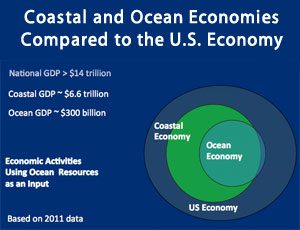Update: Applications for the CCST Science & Technology Policy Fellowship Have Closed
A ‘BlueTech’ Future: Understanding California’s Maritime Opportunities
November 4, 2015 | CCST Newsroom | Contact: M. Daniel DeCillis

The importance of high-tech innovation to California’s economy has long been understood and appreciated. Despite this fact, the current and potential impact of maritime technology innovation has been little studied, and California should focus more on this dynamic growth sector in years to come, according to The Maritime Alliance.
“The coastal and ocean economies already comprised $6.6 trillion of the national GDP based on 2011 numbers,” said Michael Jones, President of The Maritime Alliance, who spoke at the October 2015 CCST Co
uncil Meeting. “Understanding the size of the US ‘Blue Economy’ is critical if California is to take advantage of opportunities for growth in maritime related industries.”
The term “BlueTech” is becoming shorthand for the community of inventors and companies big and small involved in maritime (ocean and water-related) technology industries. It encompasses, among
other things, aquaculture; water treatment; ocean energy production (including tidal, wave, and wind generation); biomedicines from the seas; maritime robotics, and even real estate (floating infrastructures such as oil and gas drilling platforms and future uses like floating ports, desalination and power plants).

The non-profit The Maritime Alliance (TMA), which is the cluster organizer for the San Diego maritime technology community, began in 2007 and is mapping, studying, and promoting the San Diego “BlueTech Cluster”. TMA also has an active outreach program to help foster the growth of BlueTech clusters nationally and internationally.
“Traditional classification of industries leads policymakers to underestimate the importance of the Blue Economy,” said Jones. “As an example, U.S. government statistics estimate the San Diego Blue Economy to be approximately $1.8 billion (net of maritime tourism), but a broader assessment by TMA indicated the figure is closer to $14 billion annually. Traditional NAICS codes [North American Industry Classification System] don’t begin to properly identify BlueTech industries.”
San Diego, however, is a region which does seem to appreciate the value of BlueTech. It is already the largest BlueTech cluster in the United States . It also is home to the last major shipbuilding center on the West Coast. With nearly 19,000 jobs and annual revenue of over $6 billion, maritime technology industries are a fast growing sector of the region’s larger Blue Economy with 46,000 jobs and $14 billion in annual direct revenue.
In early 2015, the City, County, and Port of San Diego each unanimously adopted a “BlueTech Vision” resolutionfor the region. In November 2015, TMA will host five events focusing on BlueTech, including the 7th annual BlueTech & Blue Economy Summit and Tech Expo, which will include participants from BlueTech clusters in Canada, France, Ireland, the U.K. and the US.
TMA’s Mission is to “Promote sustainable, science-based ocean and water industries.” It is trying to do that in the San Diego area through a combination of collaboration and planning.
“Effective Marine Spatial Planning could increase the gross product of ocean and water-related industries in San Diego dramatically – billions of dollars annually – by establishing needed rules & regulations and pre-approving appropriate sites that would encourage investment and industry growth,” said a 2014 report prepared for TMA by a group of graduate students at the School of Global Policy and Strategy at the University of California, San Diego (formerly the Graduate School of International Relations and Pacific Studies).
The key to encouraging BlueTech clusters is in the recognition of opportunity and the ability to effectively collaborate across three sectors – education/research; government & policy makers/influencers; and industry, according to Jones.
“There are numerous factors BlueTech clusters need to address, ranging from the development of marine engineering and maritime technical training to the ability to affordably rent near the water,” said Jones. “Creating an effective regional and national Blue Voice for BlueTech is critical for promoting sustainable, science-based ocean industries with good paying Blue Jobs.”






